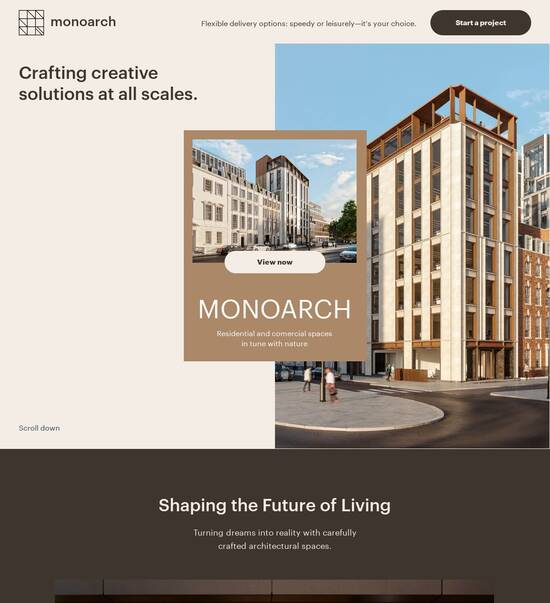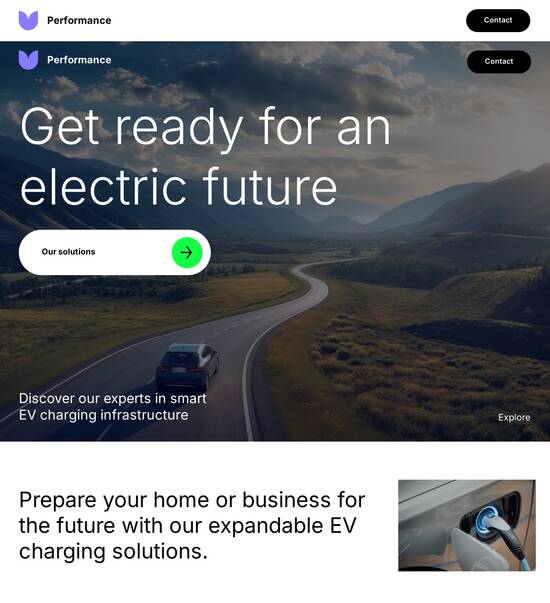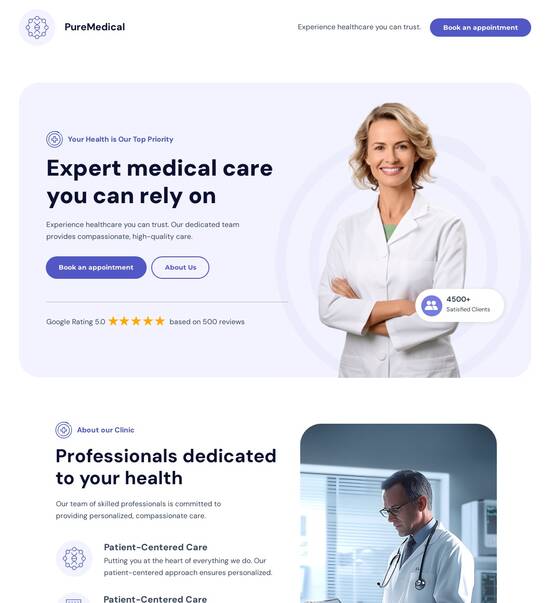
Basic brochure website template
Explore Similar TemplatesAbout template
Drive more leads with Instapage basic brochure website template built to maximize conversions. Easy customization - no designer or coding skills needed.
Recommended templates

Easy to build without coding
With the intuitive drag-and-drop builder, anyone on your team can create high-converting pages without any knowledge of code or design. Make enhancements to your landing page with custom widgets using Javascript, HTML/CSS, or third-party scripts.

Multiple layouts for any industry and goal
Select from 500+ landing page layouts built to boost conversions across industry-specific scenarios. Customize them by adjusting fonts, adding images, and generating on-brand content with the AI assistant. Quickly scale with Instablocks® and Global Blocks that you can save, reuse, and update globally.

Loads fast and looks polished on any device
Every template is responsive, which means they present professionally on any device and load blazingly fast with our Thor Render Engine. You can also power them up with Google AMP technology to deliver an unparalleled mobile experience and drive higher conversions.

Robust analytics & experimentation
Get real-time updates and reporting across all your devices, showing the number of visitors, conversions, cost-per-visitor, and cost-per-lead. Launch AI-powered experiments, run A/B tests, and use heatmaps to analyze user behavior, then optimize your landing page to maximize conversions.







Easy to build without coding
With the intuitive drag-and-drop builder, anyone on your team can create high-converting pages without any knowledge of code or design. Make enhancements to your landing page with custom widgets using Javascript, HTML/CSS, or third-party scripts.
Multiple layouts for any industry and goal
Select from 500+ landing page layouts built to boost conversions across industry-specific scenarios. Customize them by adjusting fonts, adding images, and generating on-brand content with the AI assistant. Quickly scale with Instablocks® and Global Blocks that you can save, reuse, and update globally.
Loads fast and looks polished on any device
Every template is responsive, which means they present professionally on any device and load blazingly fast with our Thor Render Engine.
Robust analytics & experimentation
Get real-time updates and reporting across all your devices, showing the number of visitors, conversions, cost-per-visitor, and cost-per-lead. Launch AI-powered experiments, run A/B tests, and use heatmaps to analyze user behavior, then optimize your landing page to maximize conversions.
All the features you need to build lead-generating landing pages
Explore more featuresLearn how to build top-performing landing pages for any goal
FAQs
Leading the way in building high-performing landing pages





A step-by-step guide to building high-converting landing pages with Instapage
Creating high-converting landing pages is essential for marketers aiming to maximize ROI. Instapage's powerful platform equips you with tools to accelerate, optimize, and scale your digital marketing campaigns. This step-by-step guide will demonstrate how to leverage Instapage’s features effectively.
Step 1: Choosing the right template
Instapage offers over 100 ready-to-use, high-converting templates tailored for diverse industries. Selecting the right template is crucial as it forms the foundation of your landing page.
- Consider your target audience: Identify the audience's preferences and behavior.
- Align with your campaign goals: Choose a template that serves your marketing objective, whether it’s lead generation or product promotion.
- Optimize for mobile: Ensure the template is responsive for users on various devices.
Step 2: Customizing your landing page
Once you’ve chosen a template, it’s time to customize your landing page. Leverage Instablocks to quickly edit and personalize page elements.
- Dynamic text replacement: Personalize headlines based on ad campaigns to match visitor expectations.
- Pre-built lead generation elements: Add forms and call-to-action buttons directly to your page for maximum engagement.
- Visual content: Use high-quality images and videos that resonate with your brand message.
Step 3: Optimization and testing
To ensure your landing page performs at its best, optimize it through built-in experimentation features. Conduct A/B tests to learn what resonates with your audience.
- Utilize heatmaps: Gain insights into user behavior on your page to identify areas for improvement.
- Set up analytics: With Instapage’s comprehensive dashboard, monitor key metrics that inform conversion success.
- Iterate: Use feedback and testing results to tweak your page for higher conversion rates.
By following these steps, marketers can effectively leverage Instapage’s powerful features to create landing pages that convert.
To unlock the potential of your digital marketing initiatives, consider implementing these strategies today.
Get started with Instapage now to turn your campaigns into success stories.
Understanding the Backbone of a Basic Brochure Website Template
Essential features of brochure website templates
A basic brochure website template serves as a digital storefront, offering essential features tailored for user engagement. One of the most critical aspects is a user-friendly design, which includes streamlined navigation that enhances the user experience. Visitors should find it easy to locate information without feeling overwhelmed, fostering a seamless journey through the site. A well-organized layout ensures that users can access vital details about a business’s offerings conveniently.
Another important element is responsive compatibility. In an era where users access websites on a range of devices, a template must adapt seamlessly across various screen sizes. Mobile optimization is increasingly vital; as more users browse from smartphones and tablets, having a brochure site that retains its functionality and aesthetic appeal on different devices can significantly impact user retention rates.
The role of HTML and CSS in brochure templates
HTML and CSS form the backbone of any effective brochure website template. The HTML structure dedicated to content organization employs semantic elements that not only enhance readability but also improve search engine optimization (SEO). Utilizing proper headings, paragraphs, and lists contributes to a logical flow of information, making it easier for both users and search engines to navigate the content.
CSS styling is equally crucial as it brings an aesthetic appeal to the brochure website. Here, customization options for colors, fonts, and layouts play a significant role in branding. A strong visual hierarchy can guide visitors through the content, emphasizing essential elements and encouraging desired actions, such as contacting the business or exploring services.
Interactive elements and their significance
Incorporating interactive elements enhances the overall functionality and engagement of a brochure website. JavaScript proves invaluable in this regard, facilitating dynamic features that elevate user interaction. For instance, implementing image sliders, modals, or even form validation can create a more immersive browsing experience. These features enrich the site, making it more engaging for visitors.
Understanding `document.addEventListener` is essential for creating a responsive browsing experience. By employing event listeners, you can efficiently handle user interactions and enhance the site's interactivity. For example, using event listeners for buttons and links allows developers to trigger specific actions, such as opening a modal or navigating to a different section of the site, thus adding layers to user engagement.
Optimizing the user experience with `DOMContentLoaded`
`DOMContentLoaded` is a fundamental event in web development, marking the moment when the initial HTML document has been completely loaded and parsed. This event is particularly important because it differs from the `load` event, which waits for stylesheets, images, and subframes to finish loading. By utilizing the `DOMContentLoaded` event, developers can manipulate the DOM effectively, ensuring that dynamic content and interfaces are ready for user interaction without unnecessary delays.
Effective techniques for handling events after the page has loaded can significantly enhance user experiences. Examples include toggling visibility of certain elements or dynamically updating content based on user input. These techniques not only contribute to better usability but also optimize load times, a crucial factor in keeping users engaged.
Integrating essential pages in a brochure website template
A well-structured brochure website typically incorporates several essential pages, each serving a unique purpose. The homepage acts as the digital front porch, making a strong first impression. It should be welcoming and informative, showcasing key content like featured services or client testimonials that effectively capture visitors' attention.
The 'About' page is critical for building trust and credibility. Crafting a compelling narrative about the business, integrating visuals like team photos or company milestones, helps personalize the brand and establish a connection with visitors. The services or products page should provide detailed descriptions written in persuasive language, using bullet points for clarity and easy reading. Finally, the contact page is vital for facilitating communication, featuring essential contact information and forms that encourage user inquiries through effective calls to action.
The benefits of using brochure website templates
Brochure website templates present cost-effective solutions for businesses looking to establish an online presence without the burden of custom website design costs. Compared to bespoke design options, these templates can significantly reduce expenses while also speeding up deployment, allowing businesses to enhance their time-to-market. This combination of affordability and efficiency makes brochure templates an attractive choice for many.
Accessibility and ease of use are other major benefits of brochure website templates. Many templates are designed with non-technical users in mind, enabling them to manage content effortlessly. Additionally, the diversity of available templates caters to various industries, ensuring a broad range of businesses can find suitable options. By utilizing these templates, companies can boost their online presence, as a professional-looking brochure site positively impacts branding and incorporates essential SEO practices.
Advanced customization and flexibility
While brochure templates provide a great starting point, they also allow for advanced customization. Businesses can implement custom features through various plugins that enhance functionality. It’s important to choose reliable plugins that are frequently updated and compatible with the chosen brochure template, ensuring longevity and performance of the website.
Finding the balance between pre-designed layouts and individual branding is crucial. Businesses must strategically tailor templates to reflect their unique identities while retaining the core benefits of the existing design. Personal branding remains essential, as originality can set a business apart, even when using template-driven designs.
Incorporating visuals and multimedia
Visual elements are key to engaging visitors on a brochure website. Using high-quality images can significantly enhance the user experience, so it's crucial to select and optimize images thoughtfully. This includes not only selecting eye-catching visuals but also ensuring they are correctly formatted for faster load times. Additionally, alt text for images serves a dual purpose: enhancing accessibility for users with disabilities and contributing to SEO efforts.
Incorporating videos and graphics can further elevate a brochure website's effectiveness. Best practices for embedding multimedia content involve ensuring the videos are relevant and that they load quickly to maintain user engagement. Videos often convey messages more effectively than text alone, helping to illustrate services or showcase testimonials in compelling ways.
Examples of successful brochure websites
Observing successful implementations of brochure websites across different industries can offer valuable insights. Case studies highlight how businesses from healthcare to e-commerce have creatively leveraged brochure templates to present their services. For instance, healthcare providers often prioritize user-friendly navigation, ensuring patients can easily access information about services, locations, and contact details.
Key takeaways from these successful templates usually revolve around clean design, effective use of white space, and strategic CTAs. Notable examples showcase how a focus on user experience can lead to better engagement and conversion rates. Understanding these lessons can equip new businesses with the tools they need for creating impactful brochure websites.
Transitioning from a brochure site to a fully-functional platform
Recognizing when it is time to upgrade from a basic brochure website is essential for businesses as they grow. Indicators may include an increase in products or services offered, a rise in traffic, or the need for more complex functionalities. Transitioning to a more robust platform could involve integrating e-commerce features or utilizing CRM systems to manage customer interactions.
Planning for scalability is crucial during this phase; migrating to solutions such as content management systems or fully-customized websites can enhance effectiveness. As technology advances, monitoring future trends in website templates will remain essential. Innovations such as AI integration in web design may change how templates are crafted, leading to even more personalized and efficient user experiences.
Ready to skyrocket conversions?
Supercharge your ad campaigns with high-performing landing pages
Get started














